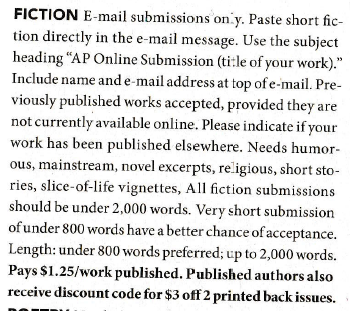Last week, we talked about the hoops I jumped through to make sure my short story ‘The Cow’ was ready to be published. I completed all the steps, and now I feel confident that the story is ready.
But what kind of story do I have?
When you check out a publisher’s website or read a literary magazine’s call for submissions, you’ll notice that they have very specific ideas of what they’re looking for.
You must pay attention to what they’re saying. Because that is the easiest and best way to find a publisher who is looking for work like yours.
Let’s face it, your story about a man in a boat talking about life and the universe might be the greatest thing since Life Of Pi, but trying to get it published in your favorite woodworking magazine is going to be a waste of time and effort on everyone’s part.

So before you go looking for a publisher who wants your type of work, you have to know what type of work you have.
And to truly know what type of work you have, you’ll have to answer two questions: What is it? and What do I want to do with it?
What is it?
Take a second look at your completed manuscript, and try to put yourself in the reader’s shoes. Then ask yourself: what is it’s…
Genre (If Any) – Good stories may cross multiple genres, but you have to have an idea of what the core genre would be for your work. If your story doesn’t really have a genre because there’s a lot going on, try for ‘literary’. If your story doesn’t really have a story because it’s out there, go for ‘experimental’.
Word Count – Literally just… count. Most word processing software is happy to help you with this.
General Audience – Would it be a good idea to show this story to someone at work? To your grandmother? To kids? At a biker bar? Make sure you know the type of person who would be delighted to get a chance to read this story.
General Tone – What will your ideal reader feel when they finish your story? Happy? Relaxed? Excited? Slightly unnerved?
The answers to these questions will give us a good idea of what benchmarks a story hits. This will be invaluable when we start looking through calls for submission like the one above.
What do you want to do with it?
No matter what type of story you have, there are dozens of ways to get it published. So you’ll need to figure out how you are submitting this and how much you’ll get paid.
How am I Submitting This? – Using your answers from the questions above, you’ll need to create a rough list of publishers who have an interest in works like yours. Then you’ll need to ask yourself which ones you’ll actually be submitting to.
Think about the submission methods you feel comfortable with: Will you only send SASEs and physical copies? Will you only submit online? Will you ever submit your work to a publisher who charges a small reading fee?
Then ask yourself if you’ll be submitting your work simultaneously. While some publishers see simultaneous submissions as a faux pas at best and an insult at worse, most publishers understand that writers aren’t going to wait around for six months for a ‘no’. (And, thankfully, publishers who have a venomous hatred of simultaneous submissions are more than happy to tell you so.)
When it comes to submitting simultaneously, experts say there’s etiquette to be considered. From submitting in tiers, to warning against any move that could make you an enemy of the editor.
In general, be up front in your query letter if you’re worried you’re doing something that the publisher might consider tacky, and be ready to politely withdrawal your work if something comes up.
What range of payment should I accept? – Unless you have absolutely no writing credits to your name, you must receive some sort of payment for the majority of your published work.
Working for free or working for exposure is something all writers have done. There are several very well respected journals, magazines, and websites where getting published – even for free – can truly boost your career. But there are now personal blogs, vlogs, social media accounts, and a million other respectable – and profitable! – ways to self publish out there. There is no reason for you to always accept ‘exposure’ as a payment.
Plus, the only people who will find you through that type of exposure is people who expect you to work for free. (Trust me, I learned that one the hard way.)
Before you start submitting, make sure you have a set bottom line. Even if that bottom line is a $5 payment or just a couple of contributor’s copies. If your story is good, there WILL be someone out there who is willing to pay you for it.
And – this is pretty obvious, but it bears repeating – NEVER pay a random company hundreds or thousands of dollars to publish your stuff. If you have a psychological need to see your name in print, you can work something out through Amazon or one of the many, many, many self publishing options out there.
But how do you get a list of publications that might be interested in your story? We’ll get into that next week, in part 3.
